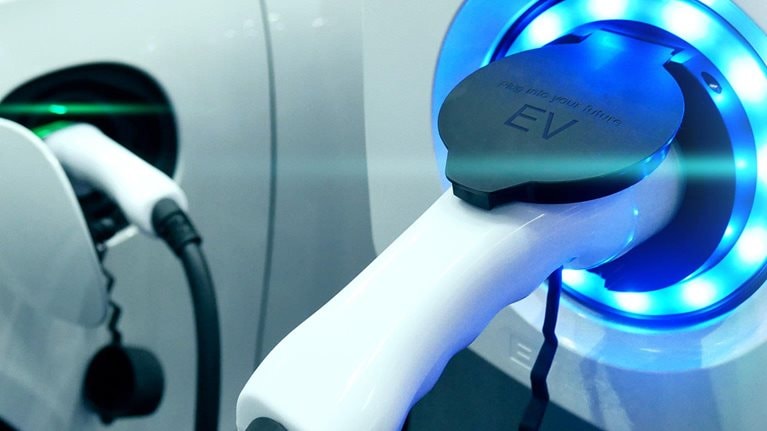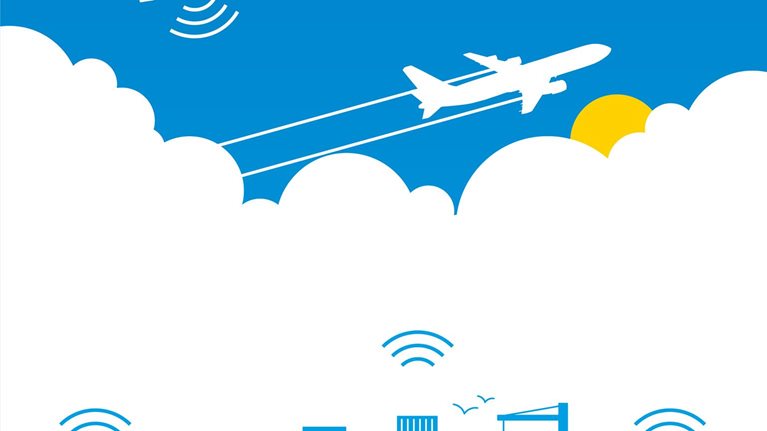Could your next commute involve a “flying taxi?” Even today, in major cities such as Hong Kong and New York, a fortunate few escape the gridlock and congestion on the ground altogether by taking helicopters to and from work. Each day in São Paulo, for example, hundreds of people trade a four-hour commute on the ground for a ten-minute helicopter ride costing anywhere from $500 to $1,500. While expensive for everyday commuters, the dream of rising above the ever-increasing road-traffic congestion, coupled with the promise of new technological advances, explains why the idea has recently gained significant momentum. In fact, the media buzz surrounding the topic has grown more than tenfold in the past 18 months, as measured by mentions of personal air mobility and similar terms.
Stay current on your favorite topics
What if the cost of flying over congested traffic were to fall to $150 or less? The flying taxi of the future—enabled by vertical takeoff and landing (VTOL), electric propulsion, and advanced flight control capabilities—could achieve these lower prices. This flying taxi will be energy efficient, quiet, nonpolluting, and eventually pilotless. Investments in technologies like batteries, autonomous systems, and vehicle platforms have already exceeded an estimated $1 billion in less than three years. New players are entering the arena, challenging more established companies and potentially disrupting the aerospace and automotive status quo.
Big or really big market?
The concept of flying “cars” has captured the imaginations of people in already-involved industries, like aerospace, and others, such as automotive OEMs, start-up players, and venture capitalists. However, uncertainties remain as to how large (and profitable) the market will ultimately become, and—even more important—what business models will make the markets work and where value pools will be. At a minimum, it seems reasonable that niche markets will spring up around the world, driven by local champions using mostly existing infrastructure and current regulatory frameworks, targeting passengers who value their time but cannot quite afford a full helicopter charter. In some cities, entrepreneurs are already experimenting with “app based” helicopter business models that make urban flying more accessible. Even if nothing else changes, existing technology, as a lower-cost alternative to traditional rotorcraft, will make those business models even more viable.
Exhibit 1 provides a conservative estimate of the “base case” flying taxi market, revealing a pathway to an operator market of approximately $1.5 billion by 2040.1 In this scenario, personal air mobility remains a luxury option and does not achieve scale. Vehicles remain expensive (somewhere between $750,000 and $1.5 million each), with an operating cost that improves somewhat versus today’s helicopters (about $3 per seat-mile compared with roughly $4 to $6 per seat-mile for traditional helicopters), and operators use mostly existing infrastructure. That said, a consumer price point per mile of anywhere near direct operating cost will still require significant business-model innovation. Even the smallest helicopter today commands more like $30 to $50 per passenger-mile in the charter market to offset the costs of empty legs, less than full occupancy on many flights, and overhead, as well as to ensure the operator has some profit.

But assuming a price point similar to black-car pricing, the market could support approximately 1,000 vehicles per year. That’s big, but not really big. Yet there is precedent in the disruptive mobility space of starting at the high end and moving down to the mass market over time. Electric vehicles and GPS navigation come to mind in this respect. There is no question that the potential market of people who want to move through cities more quickly is potentially next to unlimited. The real question is, what will it take to unlock that potential?
Unlocking a $500 billion-plus market
Counter to the base-case estimate above, imagine an ecosystem of players including OEMs, suppliers, maintenance and charging companies, infrastructure players, investors, regulators, and policy makers coming together and overcoming key challenges related to technology, regulation, cost, and customer acceptance to achieve higher adoption rates. In this scenario, the worldwide market could grow to $500 billion to $600 billion annually.
Would you like to learn more about the McKinsey Center for Future Mobility?
To grow the flying taxi market to this size will require radical changes, such as automotive-scale manufacturing, pilotless flying, a total rethink of air traffic control, cost-effective physical and charging infrastructure, as well as high vehicle-utilization levels. A rationale exists for achieving this scale, but it will require several enablers to become reality, which is no simple task and could take a long time.
Fully electric propulsion and the importance of energy density. Much of the focus for batteries has been on cost per energy storage (for example, dollar per kilowatt-hour). But for aviation, which fights a constant battle against gravity, the metric of energy density (watt-hour per kilogram) is even more essential. The industry must achieve the battery performance required to sustain electric vertical take-off and landing (eVTOL). To enable this, battery density must nearly double from today’s approximately 200 watt-hours per kilogram, and these batteries must achieve aviation-grade safety standards. This is critical to reduce the noise and cost of operating these vehicles.
Regulatory support. Regulators must certify the new batteries, electric motors, distributed propulsion systems, features of autonomous flight, and vehicles integrating these components, as well as approve the operation of eVTOL aircraft at low altitudes and above people in cities. This must be done in a manner that addresses noise and safety issues in a manner acceptable to all. Without this, vehicles will not be able to access routes where most people travel.
Air traffic control system. Regulators, traffic control agencies, software players, and others must create, test, and implement the technology platform for unmanned traffic management (UTM). The traffic volumes expected in this market will far exceed any low-altitude flight in a city today. To manage this much higher flight volume safely and efficiently at low altitudes, the industry needs an entirely new system that does not depend on individuals and is interoperable with existing air traffic control systems.
Fully autonomous, pilotless flight. Technology and regulation must allow full autonomy for flying taxis. This will require technology platforms that are interoperable (that is, that work across multiple vehicles), can effectively communicate with the UTM system across cities, and are able to meet the necessary safety standards required for regulatory approval. Full autonomy is critical to achieve the scale needed to address pilot shortages and ensure all available seats can be leveraged for revenue generation.
Vertiports and physical infrastructure. Infrastructure players, investors, and others must come together to create the physical and charging infrastructure required for flying taxis to efficiently land, take off, charge, and receive maintenance. Delivering expected time savings for passengers will require ubiquitous vertiport locations and achieving enough scale will require huge increases in vertiport density over time. It is likely that first movers will have an advantage by securing the most attractive sites along high-traffic routes.
Customer acceptance. Eventually, the scale of the market will hinge on customer acceptance. Customers must become comfortable climbing into the equivalent of a flying sport-utility vehicle without a pilot, which could take time across all demographics and trip types. The customer journey will need to be a pleasant one, with an interior that is quiet, at a comfortable temperature, and designed to allow passengers to use time productively if they so choose.
The fundamental result—90 percent lower operating cost. Overall, for large-scale customer adoption and the mass market, trip costs must ultimately compete with ground travel. That means the cost of a trip must decline by more than 90 percent compared with the estimated $4 to $6 in direct operating cost per seat-mile that helicopter travel costs today (Exhibit 2). Once the industry attains the above enablers, it can achieve the lower costs that can allow mass adoption.

Looking across the set of enablers, it is clear that no single player can deliver all of them alone. Instead, a broad ecosystem of stakeholders must come together to make them happen.
Not all enablers are equal
The impact of each of the above enablers is difficult to untangle because they are highly interrelated, and progress in one area will likely affect work in another. While market enablers must happen to achieve scale, they will not each have an equal impact. Much effort now focuses on the technology and regulation, but infrastructure density will likely play the biggest role in driving scale once the technology is ready and regulatory reform passes.
Here is why: the closer passengers are to a vertiport, the greater their potential time savings and the more an air-taxi trip makes sense (Exhibit 3). Take a 40-mile commute into a city center from an airport, for example. Driving in traffic takes about 90 minutes; using a flying taxi from a vertiport that is 15 minutes away would take less time but would still be about an hour. If the vertiport were two to five minutes away, that could cut the trip down to 30 minutes. The distance to the vertiport dramatically affects the time saved and determines whether the trip is worthwhile from a commuter’s point of view.

To illustrate the importance of infrastructure density as a market enabler, consider its impact on market size relative to trip price. Our models suggest that reducing trip price by a factor of ten would likely increase the market size fivefold. However, reducing the average distance to the nearest vertiport from about 30 minutes to about three would expand the market 25 times.
Simply put, the more infrastructure there is, the more trips it “makes sense” for a passenger to fly. Consequently, lacking enough infrastructure, only a handful of trips exist where it would make sense to fly. In this situation, reducing costs would make only a few more of those trips feasible.
Finding the industry’s profit centers
At any market size, the personal-air-mobility market will generate new sources of value. Nonetheless, finding the most profitable ones will be a challenge. Initially, when personal air mobility is a niche market, the vehicle itself will serve as a critical control point because of its expense and likely price premium. At this stage, sales will probably number a few hundred units per year. The vehicle will also serve as a lynchpin for downstream services—particularly maintenance and repair.

Public–private collaborations for transforming urban mobility
The at-scale market implies a different world—one in which at least 25,000 vehicles sell per year in the United States alone at prices below $250,000 each. This price point will emerge as the industry achieves manufacturing scale and the vehicle platform commoditizes. In this scenario, downstream services like UTM and infrastructure are much more likely to be larger, with higher-margin profit pools. This is because these services will feature higher complexity and end up having higher barriers to entry once a player builds a viable solution.
The clear imperative for early-market players involves finding a value proposition that extends beyond the vehicle and that adapts over time. While the aircraft may be a control point in the initial market, it is unlikely to remain the most attractive play if the market reaches scale and the vehicle becomes commoditized.
Helping the personal-air-mobility market take off
Getting the flying taxi industry off the ground will require a team effort. Potential industry stakeholders include regulators, start-ups, traditional airplane and automobile manufacturers, cloud-based technology players, electric-vehicle (EV) charging networks, private-equity companies, venture capitalists, financing entities, commercial-real-estate developers, civil architecture firms, and insurance companies, to name only a few. Given this eclectic group of players, different stakeholders will require tailored investment strategies to support the market and to allow for businesses to position themselves to profit from the disruption.
All players need to invest in understanding the potential structure of the ecosystem: Will it be a platform model with a consumer-facing app at the center and commodity capacity such as vehicles and vertiports plugging into it? Will it be a few large players that will own the ecosystem end to end, factory to app? Will it be much more like today’s aerospace and automotive industries, with OEMs and operators each playing their role? Beyond this core strategic question of the structure of the ecosystem—and what actions will shape the industry to the preferred model—stakeholders need to take specific actions to set themselves up for success in the market.
Regulators. Regulators might consider focusing on five primary actions. First, develop new aircraft certification standards; second, take steps to enable the integration of the new UTM system with traditional air traffic control networks; third, enable test-flight programs; fourth, create standards and certification for autonomous flight; and, finally, provide incentives and subsidies for personal air mobility, such as current EV support.
Aerospace and automotive incumbents. Given their technical expertise and industry experience, traditional aerospace incumbents have a head start in developing vehicle platforms, the clout to help establish standards and aircraft-certification specifics, and the ability to run safe vehicle pilot programs. They also have the advanced R&D capabilities required for autonomous-flight systems and UTM. Automotive OEMs specialize in high-volume manufacturing of highly technical products—a must if large-scale fleets of flying taxis hope to get off the ground.
Software and technology players. The software and cloud infrastructure required to accelerate this disruption goes beyond the scope of traditional avionics and will attract new companies to the personal-air-mobility ecosystem. Likewise, a robust UTM system will require onboard software (detect and avoid), mapping and route-optimization tools, and external inputs such as real-time weather reports.
Physical infrastructure companies. Who will build and pay for the vertiports and charging infrastructure to bring the market to scale? One clue comes from current on-road mobility tie-ups among ride-sharing companies, commercial-real-estate developers, and charging networks for EVs. The collaborators must create high-throughput vertiports in dense urban environments, designing their networks and pricing access to pay off capital investments. These investments could range anywhere from $2 million for a small single-spot vertiport on an existing building to $200 million (or more) for a megahub with ten to 20 spots, retail, and other services built from the ground up.
How quickly personal air mobility emerges and how large the market ultimately becomes remains uncertain. We nonetheless believe the promise of flying taxis is real. Fulfilling its market destiny will require sustained funding and support across a wide group of stakeholders. Industry players thus need to focus on coming together to realize the enablers mentioned above. And beyond innovative technologies and brick-and-mortar investments, this idea will require collaboration across many industries—that are not used to working together—to create an ecosystem capable of launching a successful flying taxi industry that the everyday commuter is comfortable making a part of their mobility ecosystem.


